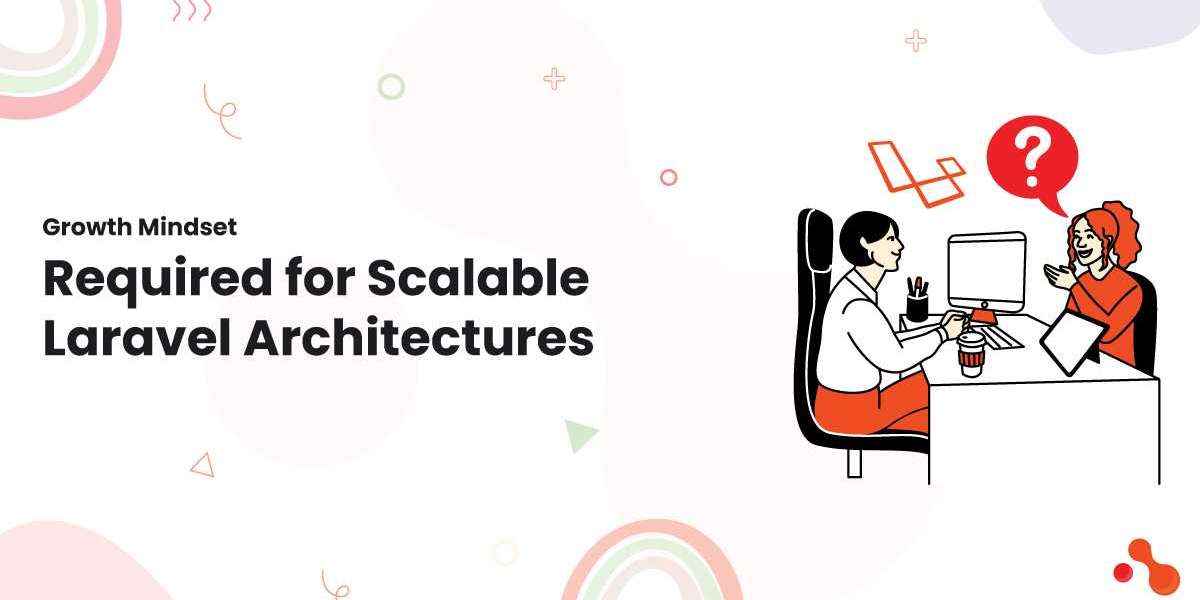Introduction
To achieve scalable Laravel architectures require a strategic approach that emphasizes not just the technical aspects but also fostering a mindset of growth within your team. A scalable application can handle increasing loads gracefully by utilizing resources efficiently and adapting to demand without compromising performance.
Scalability is the cornerstone of success for any application. Laravel, a robust PHP framework, is no exception to this rule. As your user base grows, so does the need for a system that can handle a more significant load gracefully and efficiently. Adopting a growth mindset when developing a Laravel application can be transformative, allowing you to plan for success from the outset.
Creating a scalable Laravel architecture with this type of mindset involves adopting strategies and practices that allow your application to gracefully handle increased loads and complexities as your user base grows.
Adopting this type of mindset is an ideal solution for developing scalable Laravel solutions with the future in mind. This article delves into the core principles, techniques, and best practices for achieving scalability in Laravel applications structured around the growth mindset philosophy.
What is Scalability in Laravel?
Scalability is an application's ability to handle a growing amount of work by adding resources with minimal impact. For Laravel applications, scalability means ensuring that your application can serve increasing requests without degrading performance. The primary purpose is to provide the current and future scalability of the Laravel application.
With Laravel, you have the option of using modern scaling techniques. Two modern techniques stand out for scaling Laravel applications: serverless architectures and Kubernetes. Serverless platforms, like Laravel Vapor, offer automatic scaling and reduced maintenance overhead.
Kubernetes, on the other hand, provides more control over the infrastructure and can help estimate costs more effectively. The choice between serverless and Kubernetes should be based on your project's specific needs.
Need for a Growth Mindset
A growth mindset refers to an approach or attitude that emphasizes learning, flexibility, and continuous improvement. Adopt this mindset to transform your challenges into opportunities for growth rather than obstacles.
Adopting such a mindset is highly beneficial for developing a scalable Laravel solution. This is because Laravel has a robust ecosystem and offers frequent updates. The added benefit is that it helps you keep up with the evolving landscape of web technologies.
Applying a growth mindset to Laravel development means continuously seeking improvements, being open to new technologies and practices, and being prepared to refactor and optimize your codebase as your application evolves.
Critical Strategies for Scalable Laravel Architecture
A growth mindset can do wonders for your business. It is equally applicable when you set out to develop a Laravel application. It serves the purpose of allowing you to create a better solution, one that also considers future requirements and evolving needs. Here are a few strategies with this mindset in mind:
View challenges and opportunities:
Developing complex applications with Laravel can present numerous challenges, from handling large datasets efficiently to ensuring your application can scale. A growth mindset encourages viewing these challenges as opportunities to innovate and improve rather than setbacks.
Iterative Improvement:
Rather than aiming for perfection in the first go, a growth mindset advocates for iterative development. This involves building a minimal viable product (MVP), gathering feedback, and continuously refining and improving your application. Laravel's ecosystem supports this approach through easy versioning, testing, and deployment tools.
Collaboration and Feedback:
Growth-minded developers understand the value of collaboration and constructive feedback. Laravel's community is a vast resource for learning, offering opportunities for developers to share knowledge, contribute to open-source packages, and get feedback on their code. Engaging with the community through forums, social media, or attending Laravel events can significantly accelerate learning and improvement.
Adaptability:
The technology landscape is ever-changing, and new challenges arise as user demands evolve. A growth mindset in Laravel development means being adaptable and willing to reassess and adjust your approaches, tools, and even your codebase in response to new requirements or technologies.
Resilience: Encountering bugs, performance issues, or complex feature requests is inevitable. A growth mindset helps developers maintain resilience, encouraging them to persevere through difficulties, learn from mistakes, and emerge stronger on the other side.
Contributing Back to the Community:
Finally, a growth mindset is also about contributing back to the Laravel community, whether through developing open-source packages, helping others solve problems, or sharing knowledge and experiences. This not only helps others but also reinforces your own learning and positions you as an active participant in the ecosystem's growth.
Embrace Modular Design:
Utilize Laravel's service providers to create modular components and packages that can be easily reused or replaced. This promotes a cleaner, more organized codebase that is easier to scale and maintain.
Domain-Driven Design (DDD):
Implement DDD principles to structure your application around its domain and logic, improving flexibility and scalability.
Optimize Database Usage: While Eloquent ORM is powerful, it's essential to use it judiciously. Optimize your queries and consider using the query builder for complex queries to reduce memory usage.
Indexes Caching: Ensure your database tables are adequately indexed to speed up query times. Implement caching strategies for frequently accessed data to reduce database load.
Optimize Database Interactions
Eloquent Performance:
Use Eloquent ORM efficiently by leveraging eager loading to reduce the number of database queries and by using indices in your database migrations.
Database Indexing:
Ensure your database tables are indexed appropriately to speed up query execution, especially for large datasets.
Query Caching:
Implement strategies for frequently executed queries to minimize database load.
Effective Use of Caching
Leverage Laravel's Cache Drivers:
Utilize Laravel's cache drivers (e.g., Redis, Memcached) to store frequently accessed data, such as API results, complex queries, or configuration settings.
Cache Whole Responses:
Use response caching for static or semi-static pages to reduce your application and database load.
Implement Queue Systems for Background Processing
Asynchronous Tasks:
Use Laravel's queue system to handle time-consuming tasks (e.g., sending emails, processing images) asynchronously, freeing up the application to handle more user requests.
Scalable Queue Drivers:
Choose a queue driver (e.g., Redis, Amazon SQS) that can scale with your application needs.
Laravel Horizon for Queue Management
Monitor and manage Laravel queues with Laravel Horizon to ensure background job processing reliability and gain insights into job throughput, failures, and performance.
Microservices and Service-Oriented Architecture
Decouple Components:
Consider separating your application into more minor, loosely coupled services. This allows individual components to scale independently based on demand.
API Gateway:
Use an API gateway to manage requests to your microservices efficiently, implementing rate limiting and authentication at a single point.
Scaling the Infrastructure
Load Balancing:
Use load balancers to distribute incoming application traffic across multiple servers, improving responsiveness and availability.
Docker and Kubernetes:
Use Docker's containerization and Kubernete’s orchestration to automate the deployment, scaling, and management of your application containers.
Performance Testing and Monitoring
Implement Logging and Monitoring:
Use tools like Laravel Telescope to debug and monitor your application's health in real-time.
Load Testing:
Perform load testing regularly (e.g., with Apache JMeter or Laravel's own load testing tools) to identify bottlenecks and areas for improvement.
Continuous Learning and Refactoring
Stay Updated:
Keep up with the latest Laravel releases and community best practices to take advantage of new features and performance improvements.
Code Reviews and Refactoring:
Regularly review and refactor your code to maintain its quality, readability, and performance as your application evolves.
Cache Drivers:
Laravel supports various cache drivers, such as File, Redis, and Memcached. Choose one that suits your application's needs and utilize it for caching configurations, routes, and data.
Cache Granularity:
Adopt a granular caching approach to selectively cache parts of your application, such as response caching for API calls or full-page caching for static pages.
Utilize Queues Background Jobs:
Asynchronous Processing: Use Laravel's queue system to handle time-consuming tasks in the background, improving response times for your users.
Queue Workers:
Scale your application by adjusting the number of workers processing queued jobs based on the workload.
Decouple Services:
Break down your application into smaller, loosely coupled microservices. This allows you to scale individual parts of your application independently, based on demand.
API Gateway:
Use an API gateway to manage requests between your front-end and various microservices, simplifying the development and scaling of services.
Continuous Monitoring Testing:
Implement tools like Laravel Telescope or third-party services like New Relic to monitor your application's health and performance.
Load Testing:
Regularly perform load testing to identify bottlenecks and understand how your application behaves under stress.
Foster a Growth Mindset:
Encourage your team to stay up-to-date with the latest Laravel features, packages, and best practices. A culture of learning and adaptability is crucial for scaling.
Iterative Improvement:
Adopt an agile development methodology, focusing on iterative improvements and frequent releases. This allows you to adapt and scale your architecture as your application grows and user demands evolve.
Achieving a scalable Laravel architecture is an ongoing process that involves technical excellence and a strategic approach to growth. By efficiently focusing on modular design, database optimization, strategic caching, and leveraging Laravel's built-in features like queues and Eloquent ORM, you can build a robust, scalable application ready to handle growth.
Benefits of Developing Scalable Solutions
A microservices architecture can significantly enhance the scalability of a Laravel application. By breaking down the application into more minor, independently deployable services, you enable isolated development and deployment, facilitating scaling. Complementing this with domain-driven design helps maintain a clean separation of concerns and promotes a more scalable structure.
Developing scalable solutions is crucial for handling growth and ensuring your project's long-term success and reliability. Scalability means that your application can handle a growing amount of work or its capability to be enlarged to accommodate that growth. Here are several key benefits of developing scalable solutions:
- Cost Efficiency
- Improved Performance
- Flexibility and Adaptability
- Market Responsiveness
- Long-term Sustainability
- High Availability and Reliability
- Optimized Resource Management
- Innovation and Growth Support
- Risk Management
- Competitive Advantage
- Future-proofing
Hire remote developers and gain access to highly skilled developers with the expertise to build scalable solutions. Acquaint Softtech is one such developer with over 10 years of experience.
Choose our software development outsourcing services and gain a competitive edge over your competitors.
Real World Example:
One real-world example of a scalable Laravel application is Vogue Archive.
Vogue Archive is a website that uses the Laravel framework. It contains more than 400,000 pages, including every issue of Vogue magazine from 1892 to the present day.
This digital archive represents a comprehensive platform housing over a century of Vogue magazine issues, showcasing fashion, art, and cultural history.
The website is developed using Laravel, among other technologies, and supports high traffic volumes, extensive database queries, and vast storage needs, exemplifying a scalable Laravel solution in action.
Key Features of the Vogue Archive's Scalable Solution:
High Traffic Management:
Vogue Archive caters to thousands of users simultaneously. Laravel's ability to handle multiple requests per second is enhanced through the use of advanced caching mechanisms like Redis, and queue systems like Laravel Horizon that optimize background task processing.
Extensive Database Handling:
The platform contains a massive collection of high-resolution images and articles, requiring robust database management. Laravel's Eloquent ORM efficiently handles complex queries with optimized response times, thanks to its lazy loading and eager loading capabilities. This ensures that only necessary data is fetched and processed.
Content Delivery Network (CDN):
To ensure fast loading times globally, the application integrates with CDNs. Static assets like images and stylesheets are served from edge locations closer to the user, decreasing load times significantly. Laravel's built-in support for various file systems simplifies the integration of multiple CDNs.
Scalable Hosting Solutions:
The application uses cloud hosting solutions that allow for scaling resources up or down based on traffic demands. Laravel's compatibility with cloud platforms like AWS and DigitalOcean enables seamless scaling and maintenance of the application's infrastructure.
Security Features:
When handling sensitive user data, Vogue Archive employs Laravel's built-in security measures, such as hashed passwords, secure authentication, and authorization practices, to protect user information and system integrity.
API Integration:
Vogue Archive interfaces with external APIs for additional functionalities, including search features and third-party analytics. Laravel's robust support for RESTful API development enables secure and efficient communication between the application and these services.
This example underscores how Laravel's various features, like queuing, caching, ORM, API support, and its ecosystem of packages, can be utilized to create a highly scalable and efficient web application capable of handling the complex requirements of a large-scale digital archive.
Conclusion
Building a scalable Laravel application with a growth mindset involves combining strategic planning, architectural decisions, and the right choice of technologies. By understanding scalability principles and implementing modern techniques like serverless architectures or Kubernetes, you can ensure your Laravel application is ready to grow alongside your success.
Consider exploring the resources provided for more detailed insights and strategies for building scalable Laravel applications. Scalability is about more than just handling growth. It's about designing for it.








